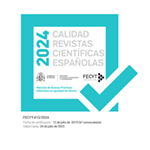Emergent technologies, networks that lurks the sociability
Abstract
This paper highlights several symptoms that can be observed in multiple societies since the installation of so called “emergent technologies”, especially technologies of information and communication. Supported on the idea that this technological capacity provokes an alteration of the culture, which becomes a connectionist neo-capitalism, we suggest that besides the constriction of the “field of the possible” produced by the system of a central market economy, the appliances and technological devices – the portable ones particularly-, exerts a new constriction and, actually, re-organization, of this “field of the possible”“. We find this as disturbing signs of loss of autonomy, such as a reduction in margins for the exercise of autonomy by individuals and collectivities. We will argue that the situation becomes sophisticated in societies with a high installed capacity of communication, information and transportation technologies. In such societies, in fact, reticular forms are lavished in multiple areas: production, provision of services (shared economy), neighborhood, school, university, etc. No doubt “the network” is the metaphor that best conveys much of what happens and the ways it happens in our daily lives. Starting from a conception of sociability, understood as the form that concurrences can adopt, the form of “doing something together”, the forms of “putting something in common”, the forms of “doing about that something put in common “, we hypothesized that with emergent technologies and social reticulation, a vector of centrifugal component that blocks, hinders or inhibits sociability has also been set in motion.
Downloads
Publication Facts
Reviewer profiles N/A
Author statements
- Academic society
- N/A
- Publisher
- Grupo de Investigación Cultura Digital y Movimientos Sociales. Cibersomosaguas
Article download
License
In order to support the global exchange of knowledge, the journal Teknokultura is allowing unrestricted access to its content as from its publication in this electronic edition, and as such it is an open-access journal. The originals published in this journal are the property of the Complutense University of Madrid and any reproduction thereof in full or in part must cite the source. All content is distributed under a Creative Commons Attribution 4.0 use and distribution licence (CC BY 4.0). This circumstance must be expressly stated in these terms where necessary. You can view the summary and the complete legal text of the licence.













